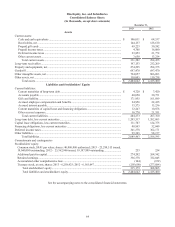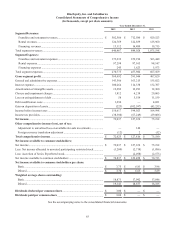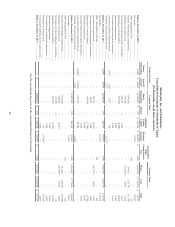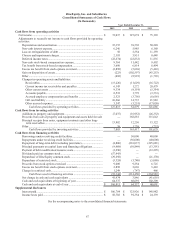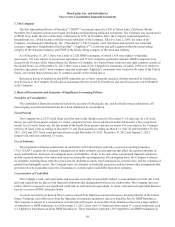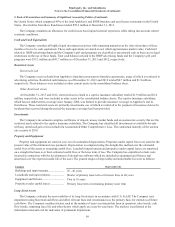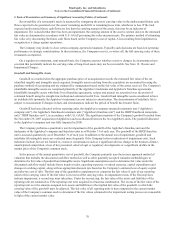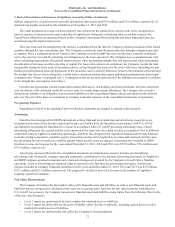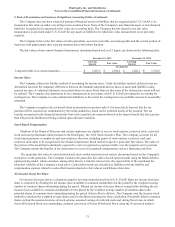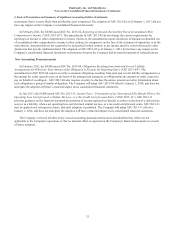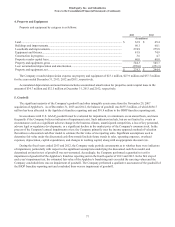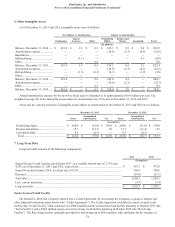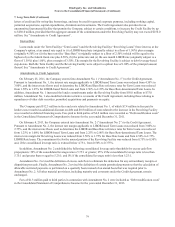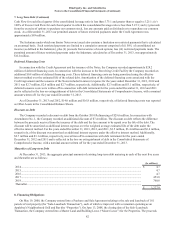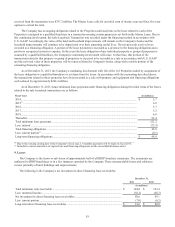IHOP 2013 Annual Report Download - page 95
Download and view the complete annual report
Please find page 95 of the 2013 IHOP annual report below. You can navigate through the pages in the report by either clicking on the pages listed below, or by using the keyword search tool below to find specific information within the annual report.
DineEquity, Inc. and Subsidiaries
Notes to the Consolidated Financial Statements (Continued)
2. Basis of Presentation and Summary of Significant Accounting Policies (Continued)
74
Other Comprehensive Income (Loss)
For the years ended December 31, 2013, 2012 and 2011, the income tax benefit or provision allocated to items of other
comprehensive income was not significant.
Treasury Stock
The Company may from time to time utilize treasury stock when vested stock options are exercised, when restricted stock
awards are granted and when restricted stock units settle in stock upon vesting. The cost of treasury stock re-issued is
determined using the first-in, first-out method.
Business Segments
The Company identifies its reporting segments based on the organizational units used by management to monitor
performance and make operating decisions. These reporting segments are as follows: franchise operations, company restaurant
operations, rental operations and financing operations. Within the franchise and company restaurant segments, the Company
operates two different restaurant concepts, Applebee's and IHOP. Applebee's has no material rental or financing operations.
Franchise Segment
As of December 31, 2013, the franchise operations segment consisted of 1,988 restaurants operated by Applebee's
franchisees in the United States, one United States territory and 15 countries outside of the United States and 1,607 restaurants
operated by IHOP franchisees and area licensees in the United States, two United States territories and eight countries outside
of the United States. Franchise operations revenue consists primarily of franchise royalty revenues, sales of proprietary
products (primarily IHOP pancake and waffle dry-mixes) and the portion of the franchise fees allocated to IHOP and
Applebee's intellectual property. Additionally, franchise fees designated for IHOP's national advertising fund and local
marketing and advertising cooperatives are recognized as revenue and expense of franchise operations; however, due to
different contractual terms in Applebee's marketing agreements, Applebee's national advertising fund activity constitutes
agency transactions and therefore is not recognized as franchise revenue and expense.
Franchise operations expenses include IHOP advertising expense, the cost of proprietary products, pre-opening training
expenses and other franchise-related costs.
Company Segment
As of December 31, 2013, the company restaurant operations segment consisted of 23 Applebee's company-operated
restaurants, 10 IHOP company-operated restaurants and three IHOP restaurants reacquired from franchisees and operated by
the Company on a temporary basis until refranchised. All company-operated restaurants are located in the United States.
Company restaurant sales are retail sales at company-operated restaurants. Company restaurant expenses are operating
expenses at company-operated restaurants and include food, beverage, labor, benefits, utilities, rent and other operating costs.
Rental Segment
Rental operations revenue includes revenue from operating leases and interest income from direct financing leases. Rental
operations expenses are costs of operating leases and interest expense of capital leases on franchisee-operated restaurants. The
rental operations revenue and expenses are primarily generated by IHOP. Applebee's has an insignificant amount of rental
activity related to one property that was retained after refranchising a company-operated restaurant.
Financing Segment
Financing operations revenue primarily consists of interest income from the financing of IHOP franchise fees and
equipment leases, as well as sales of equipment associated with refranchised IHOP restaurants. Financing expenses are the cost
of restaurant equipment.
Recently Adopted Accounting Standards
In July 2012, the Financial Accounting Standards Board (“FASB”) issued Accounting Standards Update (“ASU”) No.
2012-02, Intangibles - Goodwill and Other: Testing Indefinite Lived Intangibles for Impairment (“ASU 2012-02”). ASU
2012-02 allows an entity the option to first assess qualitative factors in determining whether it is necessary to perform a
quantitative impairment test on indefinite-lived intangibles. An entity electing to perform a qualitative assessment is no longer
required to calculate the fair value of an indefinite-lived intangible asset unless the entity determines, based on the qualitative


